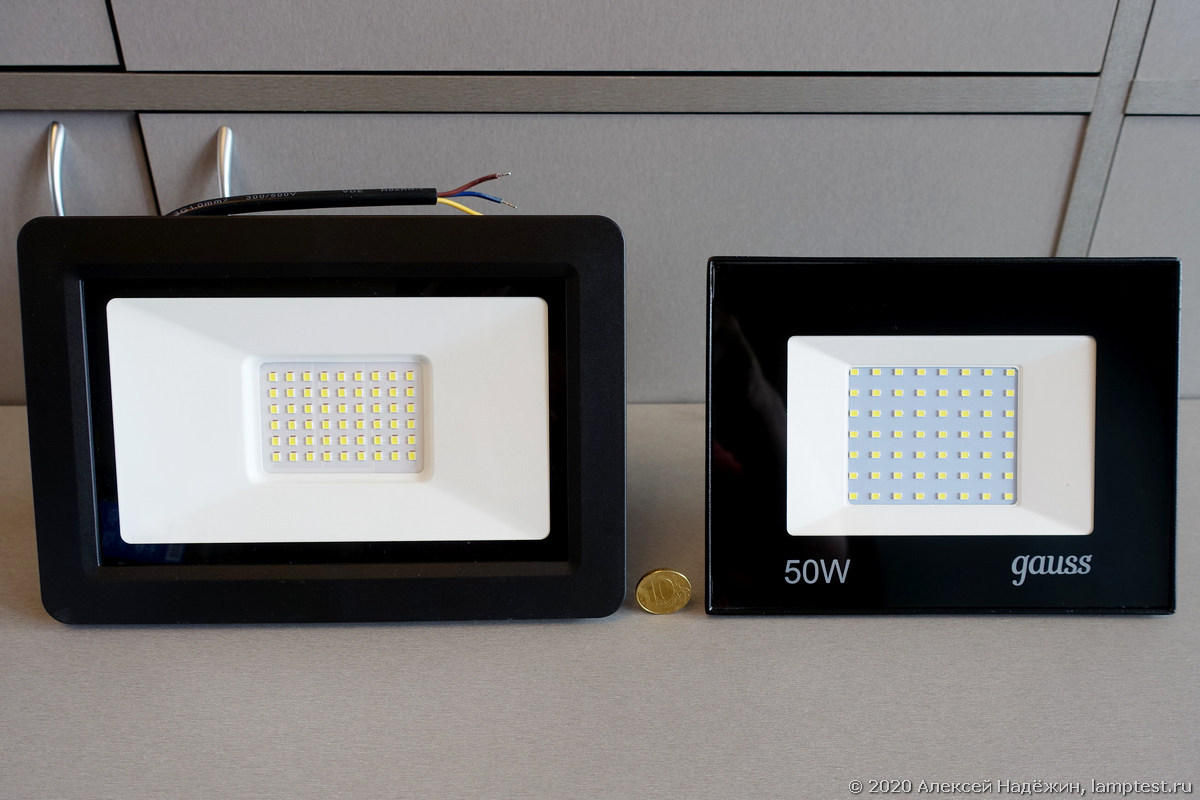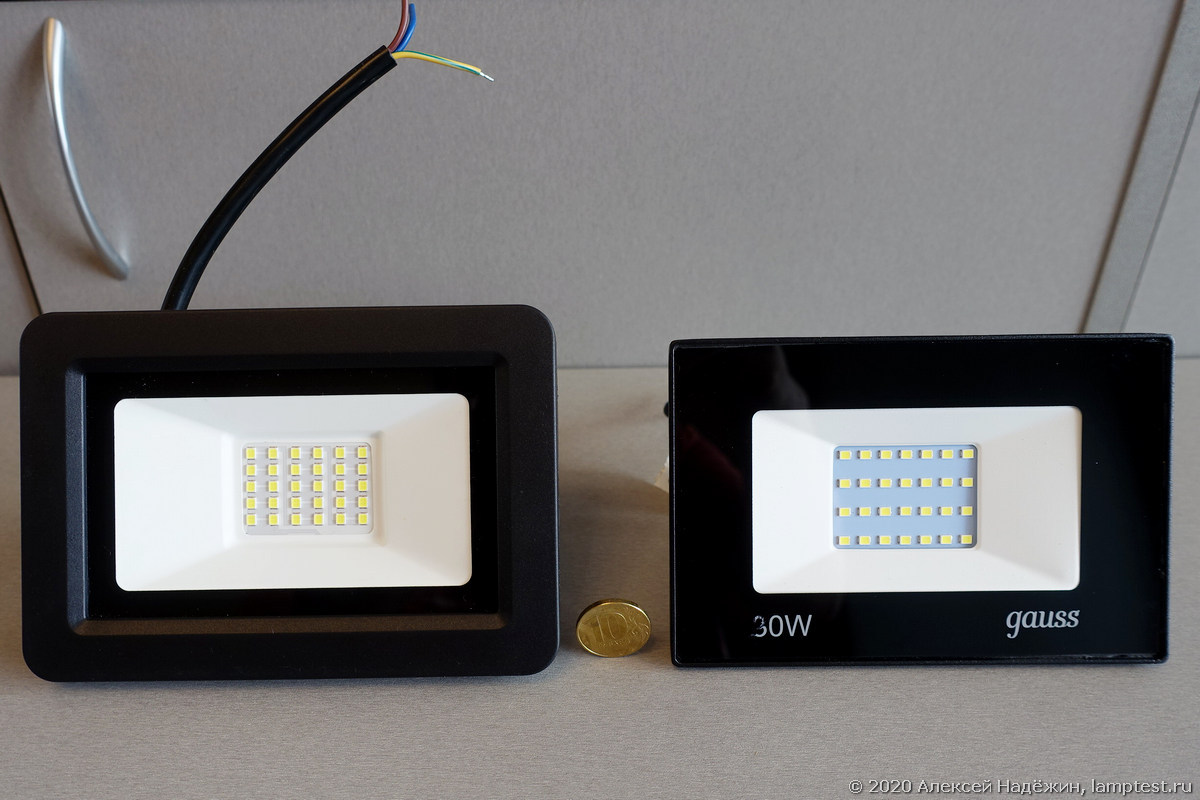Low Cost Spotlight Test from Leroy Merlin

Four Start floodlights (10, 20, 30 and 50 W) and four Gauss floodlights of the cheap Elementary series (also 10, 20, 30 and 50 W.) took part in the test.
All floodlights have a 2 year warranty.
Gauss floodlights are significantly smaller and lighter (this is a drawback, since the cooling of the LEDs can be worse, which can lead to a decrease in the operating life).
All spotlights have an aluminum housing. The Gauss front panel is made of partially tinted glass. Start in front has a plastic frame with glass inside.
Ten-watt Gauss is completely “toy”, the size of two matchboxes.

50-watt models differ in size not so much, but the difference in weight is significant.

30-watt models are close in size.

20-watt again is very different.

Spotlights Start (with the exception of the 10-watt model) are more expensive, the price of 10-watt is almost the same, the Start is even 10 rubles cheaper.

I tested the spotlights (of course, after a half-hour warm-up) and got the following results.

Spectra and results Start 50 W (left) and Gauss 50 W (right).

Unlike most bulbs, the spotlights are all honest with the power consumption (for all tested models, it differs from the rated one by no more than 10%), with a power factor (it is really higher than 0.9 for all models, as stated), with light flow (for all models, it was even higher than declared by 9-28%).
Floodlights of the two brands have different efficiencies, for Gauss it is 79-93 lm / W, and for Start it is 91-116 lm / W, therefore, with the same power, Start shines brighter.
On the packaging of the spotlights, the equivalent power of a traditional spotlight is indicated, and here the inconsistencies already begin. The start indicates for the 30-watt floodlight the luminous flux of 2400 lm and the equivalent of 200 W (this is close to reality), and Gauss writes 2100 lm and 300 W. Of course, 2100 lm this in no way can be 300 watts equivalent. And so with all models.
The color rendering index for all spotlights is declared “more than 70”, this is it (72-76). This is not enough for lighting residential premises, but for street lighting is acceptable.
All Gauss Elementary spotlights have a very high level of light pulsation (ripple coefficient 90-100%). Such a pulsation is clearly visible and can lead to eye fatigue, headaches and exacerbation of nervous diseases.
Start also has ripple, but less intense. The lowest ripple of light at the Start projector is 20 W (the measured ripple coefficient is 23%). Such pulsation is not visually distinguishable.
For projectors Start 30 and 50 W, the measured ripple coefficient is 35-36%. Such a ripple is barely visible, but will be clearly visible through the smartphone’s camera.
For 10W Start floodlights, the measured ripple coefficient was 53%. Such ripple is clearly visible.
Another significant difference between the Start and Gauss Elementary floodlights is the type of driver (internal electronics). Gauss has linear drivers. This leads to the fact that the brightness of the searchlight changes from the slightest changes in the voltage in the network and drops strongly at low voltage. When the mains voltage drops from 230 to 216-222V, the brightness drops by 5% of the nominal. At a voltage in the network of 200V, the brightness drops by 20%, at 180V, the brightness drops by half.
Spotlights Start are built on IC-drivers, so they shine without changing the brightness with a significant change in voltage in the network. The brightness of these spotlights only begins to drop when the supply voltage drops below 120 volts.
The Start floodlights work correctly with switches that have an indicator (they do not light up and do not blink when such a switch is turned off).
Gauss floodlights do not work correctly with such switches (they are dimly lit when the switch is off, moreover, all 10 LEDs are lit on a 10 W model, half of the LEDs are lit on a 20-50 W model).
I measured the maximum temperature of the floodlight housings after a 30-minute warm-up. It is expected that the smaller and lighter Gauss temperature was 6-8 degrees higher.
Luminous flux, color temperature, and color rendering index were measured using a two-meter integrating sphere and an Instrument Systems CAS 140 CT spectrometer, power consumption and Power Factor with Robiton PM2, and ripple with Uprtek MK350D. The minimum voltage level at which the luminous flux of the lamp decreased by no more than 5% of the nominal was measured using a Lamptest-1 instrument and LATR Suntek TDGC2-0.5. The maximum case temperature was measured with a Seek Thermal thermal imager.
Is it worth it to save when buying spotlights, you decide. I only recommend refraining from buying floodlights with a high level of ripple, as well as floodlights with linear drivers.
© 2020, Alexey Nadezhin





